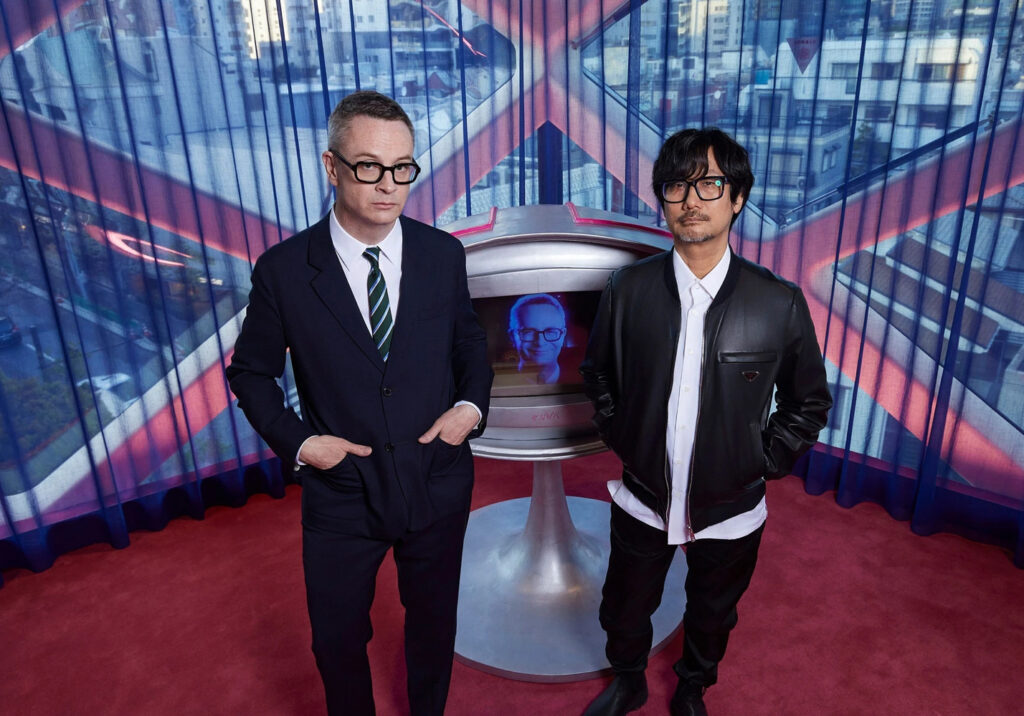
In an age where almost every aspect of life unfolds through a screen—either it’s scrolling through endless feeds, watching TikToks, or disappearing into virtual worlds—the divide between film and video games is eroding. Storytelling has become an immersive, boundary-pushing endeavor. Few creators embody this seismic shift more than Hideo Kojima, the architect of Metal Gear Solid and Death Stranding, and Nicolas Winding Refn, director of Drive, Bronson, and The Neon Demon.
Now, they’ve joined forces. Not on a game or a film, but something else entirely: “Satellites”, a multi-screen installation at Prada Aoyama Tokyo, running from April 18 to August 25, 2025. It’s not just an art exhibit—it’s a conceptual crossroads, a philosophical experiment, a hybrid creature questioning the very nature of media.
“Satellites” stages a conversation—literal and metaphorical—between Kojima and Refn. It revolves around their shared obsession: the screen. It explores themes of addiction, alienation, digital intimacy, and the fragmented consciousness of modern life. But above all, it asks a question that’s been building for years:
Are video games the new cinema? Or are we witnessing the evolution of something altogether new?
The Kojima-Refn Philosophy—Where Film and Gaming Collide
“We Are Both Addicted to Screens”
Both men are, by their own admission, obsessed with how moving images shape identity. Refn’s addiction manifests through painterly control—his films are atmospheric rituals. Silence, neon glow, and slow pacing become tools of spiritual violence. He doesn’t just show a character’s interior life—he suspends it in time.
Kojima, by contrast, composes experiences where the viewer becomes the subject. His games are visual sagas that force participation. Death Stranding, for example, isn’t just watched—it’s inhabited. You don’t empathize with the character—you become Sam Bridges. Kojima’s genius is in embedding the cinematic into the playable.
Both are fascinated by the tension between watching and doing, between feeling and acting. Refn’s still frames and Kojima’s action mechanics may seem worlds apart, but they orbit the same sun: the screen as a psychological frontier.
The “Satellites” Exhibition: A Dialogue Across Screens
“Satellites” embodies their shared visual language. Visitors navigate an installation where Kojima and Refn appear on separate screens, filmed like avatars in a sterile control room, discussing human connection and digital alienation. Their words are thoughtful, unscripted, intimate.
The space itself mimics a film set or perhaps a game level—wires, cameras, props, fragmented lighting. You don’t stand back and observe. You move through it, like a player in a virtual simulation.
Kojima and Refn are not performing so much as channeling archetypes—the screen philosopher, the haunted storyteller. Their interaction is at once staged and authentic, much like modern digital communication. It’s as if FaceTime became fine art.
There are no explicit instructions. The viewer becomes a participant, interpreting meaning from tone, rhythm, and mise-en-scène—just as in a Refn film or a Kojima game. The message is the medium. The medium is a mirror.
The Rise of Cinematic Gaming
Video games used to be toys. Then they became puzzles. Now, they are narrative engines, often rivaling or exceeding film in depth and scope.
- The Last of Us Part II blurred the lines between action gameplay and emotional cinema, delivering a morally ambiguous, heart-wrenching tale through motion-captured performances and minimalist storytelling.
- Red Dead Redemption 2 created an open-world epic where every saloon, every stranger on a horse, breathed with the tragic poetry of a Sergio Leone film.
- Death Stranding fused celebrity actors with a surreal delivery mission saga, turning isolation into both gameplay mechanic and metaphor.
This is more than polish. It’s a shift in intent. Kojima calls his work “a strand genre”—something that neither fits film nor game but instead occupies a new narrative dimension.
These aren’t diversions. They’re experiences. Games now command the budgets, talent, and fan devotion that rival and sometimes eclipse Hollywood. But more importantly, they do something movies can’t: they make the viewer responsible for the outcome.
Hollywood’s Gaming Obsession
It’s not one-way traffic. Cinema, too, is absorbing gaming’s visual grammar and structure. Directors like Edgar Wright have long flirted with the interactivity of gameplay. Baby Driver is a rhythm game in disguise, with its car chases orchestrated like Guitar Hero set pieces.
In Sam Esmail’s Leave the World Behind, glitchy interfaces, digital overlays, and nonlinear storytelling evoke survival horror games more than Hitchcock.
Refn himself has turned toward episodic and spatial storytelling. Copenhagen Cowboy feels less like a TV series and more like an explorable dream world—each scene a mood portal. There’s no guidance. No plot map. It expects you to get lost, like a Dark Souls player wandering through ruins.
As cinematic form loosens, gaming tightens. Cutscenes are now performed with Oscar-level rigor. Music, lighting, and dialogue are handled with auteur sensibilities. The camera has become a player too—dynamic, subjective, unchained.
What once felt like a technological border has become an artistic bridge.
The Future—Where Do We Go From Here?
The Next Frontier: AI, VR, and Interactive Cinema
We’re not just watching the convergence of games and film—we’re watching the birth of something new. Emerging technologies are pushing this fusion into surreal, even post-human territories.
- AI-generated narratives like AI Dungeon allow players to create and influence infinite storylines. The narrative engine adapts in real time, collapsing the distance between player and author.
- Virtual Reality experiences such as Wolves in the Walls offer complete immersion, where viewers don’t just watch—they explore, they touch, they intervene.
- Kojima’s rumored next project—a cloud-native interactive story in partnership with Microsoft—suggests a leap into persistent, evolving narrative worlds.
Refn has also hinted at branching into more abstract, real-time projects that respond to viewer interaction. In a sense, Satellites might be the first prototype: not a film, not a game, but an emotional simulation.
These aren’t just new formats. They are new languages. As with the birth of cinema in the 1890s or the first text-based games in the ’70s, we’re in a formative phase, where rules haven’t been written and everything is up for grabs.
Will Games Replace Movies?
No—but they may subvert and surpass them in specific ways.
- Games offer deep embodiment. You don’t empathize with a character from afar—you inhabit them. The moral weight of choices is yours.
- Movies offer curated intensity. Refn’s Drive doesn’t give you control—it gives you atmosphere, one you can’t escape or soften with action. That lack of interactivity becomes a form of power.
- The hybrid future is already here—Bandersnatch (Netflix), Immortality (Sam Barlow), and experimental YouTube videos show that viewers are eager to play and watch simultaneously.
What’s emerging isn’t a battle for dominance. It’s a merging of vocabularies. Film teaches games how to move hearts. Games teach film how to move hands.
“Satellites” is more than an art installation. It’s a manifesto. It declares that cinema and gaming are no longer separate forms. They’re coordinates on the same creative map—connected by ideas, aesthetics, and most importantly, emotion.
Kojima and Refn stand as prophets of this new storytelling universe. One builds interactive labyrinths of meaning. The other sculpts psychological landscapes from silence and color. Together, they show us that the future of narrative lies not in picking sides, but in breaking down walls.
In this new world:
- Viewers become explorers.
- Players become co-authors.
- Directors become world-builders.
The screen is no longer a flat surface. It’s a portal—to emotion, to memory, to collaboration.
So no, the real question isn’t whether video games are the new cinema.
It’s whether the distinction still matters at all.
Final Thought:
“Cinema is a one-way street. Games are a labyrinth. Together, they might just build a city.”
No comments yet.









